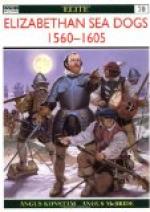Following the coast of Greenland past Cape Farewell, Sebastian Cabot turned north to look for the nearest course to India and Cathay, the lands of silks and spices, diamonds, rubies, pearls, and gold. John Cabot had once been as far as Mecca or its neighborhood, where he had seen the caravans that came across the Desert of Arabia from the fabled East. Believing the proof that the world was round, he, like Columbus and so many more, thought America was either the eastern limits of the Old World or an archipelago between the extremest east and west already known. Thus, in the early days before it was valued for itself, America was commonly regarded as a mere obstruction to navigation—the more solid the more exasperating. Now, in 1498, on his second voyage to America, John Cabot must have been particularly anxious to get through and show the King some better return for his money. But he simply disappears; and all we know is what various writers gleaned from his son Sebastian later on.
Sebastian said he coasted Greenland, through vast quantities of midsummer ice, until he reached 67 deg. 30’ north, where there was hardly any night. Then he turned back and probably steered a southerly course for Newfoundland, as he appears to have completely missed what would have seemed to him the tempting way to Asia offered by Hudson Strait and Bay. Passing Newfoundland, he stood on south as far as the Virginia capes, perhaps down as far as Florida. A few natives were caught. But no real trade was done. And when the explorers had reported progress to the King the general opinion was that North America was nothing to boast of, after all.
A generation later the French sent out several expeditions to sail through North America and make discoveries by the way. Jacques Cartier’s second, made in 1535, was the greatest and most successful. He went up the St. Lawrence as high as the site of Montreal, the head of ocean navigation, where, a hundred and forty years later, the local wits called La Salle’s seigneury ‘La Chine’ in derision of his unquenchable belief in a transcontinental connection with Cathay.
But that was under the wholly new conditions of the seventeenth century, when both French and English expected to make something out of what are now the United States and Canada. The point of the witling joke against La Salle was a new version of the old adage: Go farther and fare worse. The point of European opinion about America throughout the wonderful sixteenth century was that those who did go farther north than Mexico were certain to fare worse. And—whatever the cause—they generally did. So there was yet a third reason why the fame of Columbus eclipsed the fame of the Cabots even among those English-speaking peoples whose New-World home the Cabots were the first to find. To begin with, Columbus was the first of moderns to discover any spot in all America. Secondly, while the Cabots gave no writings to the world, Columbus did. He wrote for a mighty monarch and his fame was spread abroad by what we should now call a monster publicity campaign. Thirdly, our present point: the southern lands associated with Columbus and with Spain yielded immense and most romantic profits during the most romantic period of the sixteenth century. The northern lands connected with the Cabots did nothing of the kind.




